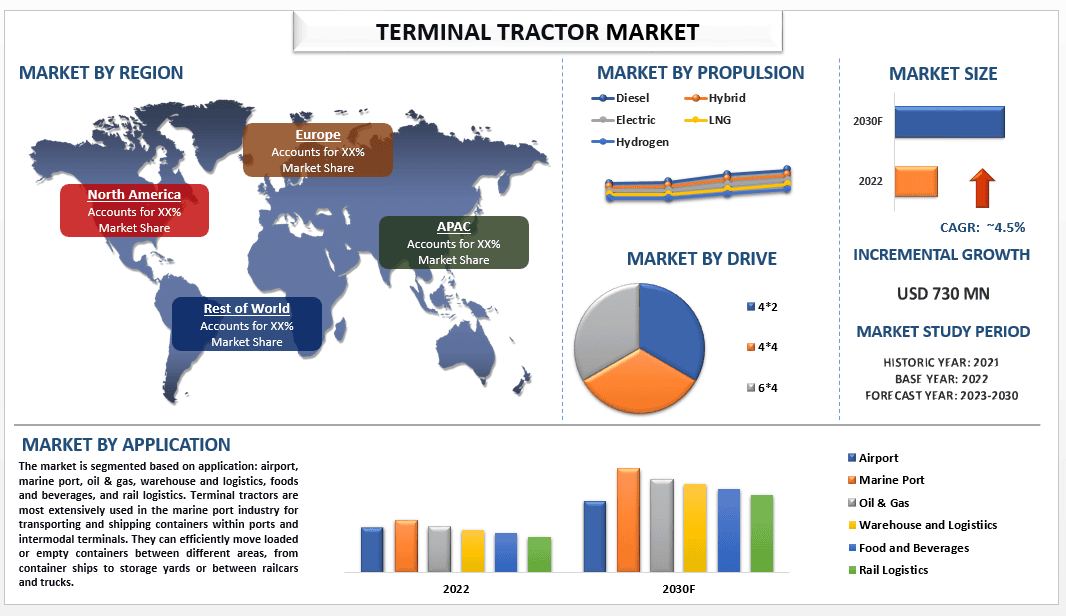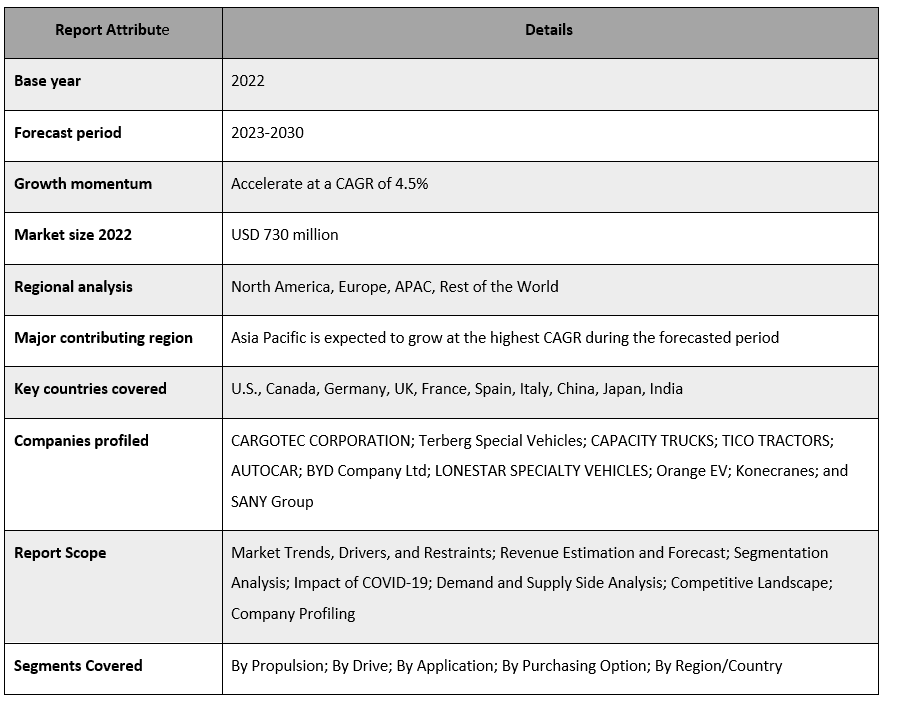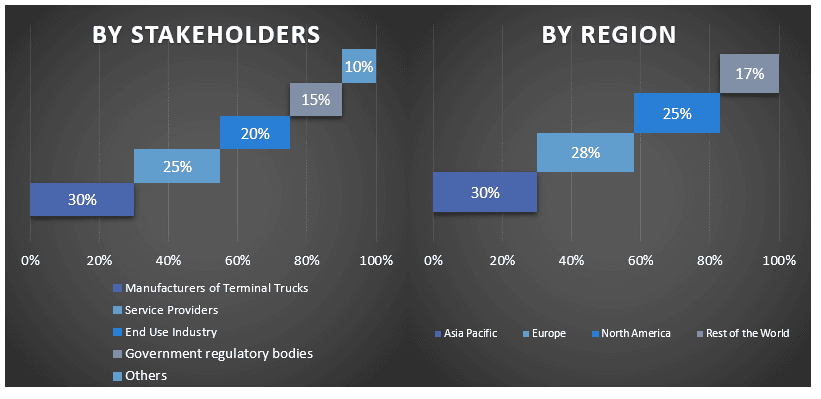- Home
- About Us
- Industry
- Services
- Reading
- Contact Us
Terminal Tractor Market: Current Analysis and Forecast (2023-2030)
Emphasis on Propulsion (Diesel, Hybrid, Electric, LNG, and Hydrogen), Drive (4*2, 4*4, and 6*4), Application (Airport, Marine Port, Oil & Gas, Warehouse and Logistics, Foods and Beverages, and Rail Logistics), Purchasing Option (Buying, Renting, and Leasing), Region/Country.

The terminal tractors market is valued at USD 730 Million in 2022 & is expected to grow at a CAGR of 4.5% from 2023-2030. A terminal tractor, also known as a yard tractor or terminal truck, is a specialized vehicle used in logistics and transportation operations to move cargo containers within a freight terminal or port facility. Terminal tractors are designed with powerful engines and have a fifth-wheel coupling for carrying and maneuvering heavy loads. The future prospects of terminal tractors are promising for several reasons such as Increasing global trade, with the growth of international trade, there is a rising demand for efficient cargo handling at ports and terminals. Terminal tractors play a crucial role in facilitating the movement of containers, ensuring smooth operations, and reducing turnaround times. Furthermore, Infrastructure development is also one of the primary factors responsible for the growth of the terminal tractor market, where many regions are investing in infrastructural development, including the expansion and modernization of ports and terminals. This investment creates opportunities for the use of more advanced and efficient terminal tractors. For instance, on March 2023, Hutchison Ports announced an investment of USD 700 Million in new container terminals in Egypt. With a capacity of 1.7 million twenty-foot equivalent units (TEUs), the new terminal will feature modern technology and equipment to deliver services to customers. The projects will be located at the Ain Sokhna Port and the Port of Alexandria. With the latest concessions, the company’s total investment in the country will reach more than USD 1.5 Billion. Overall, with the growth of global trade, advancements in technology, infrastructure development, and increasing demands for sustainable solutions and efficient logistics operations, the future prospects for terminal tractors appear promising.
Some of the major players operating in the market include CARGOTEC CORPORATION; Terberg Special Vehicles; CAPACITY TRUCKS; TICO TRACTORS; AUTOCAR; BYD Company Ltd; LONESTAR SPECIALTY VEHICLES; Orange EV; Konecranes; and SANY Group.
Insights Presented in the Report
“Amongst different propulsion, the electric terminal tractors segment is anticipated to witness a significant CAGR growth during the forecast period.”
Based on propulsion type, the market is segmented into diesel, hybrid, electric, LNG, and hydrogen. The most commonly used type of terminal tractor based on propulsion type is typically diesel-powered. Diesel terminal tractors are widely used due to their high torque, endurance, and ease of refueling. However, it’s worth noting that advancements in technology have introduced electric and hybrid-powered terminal tractors as well, which are gaining popularity due to their lower emissions and reduced operating costs, and companies have sped up the process of developing and launching products in this space
“Amongst application, the use of terminal tractors in warehouse and logistics is anticipated to grow at a strong CAGR in the market during the forecasted period.”
Based on application, the market is segmented into airport, marine port, oil & gas, warehouse and logistics, foods and beverages, and rail logistics. Among them, the warehouse and logistics segment is going a witness a significant rise in their usage of terminal tractors because of their efficient movement of trailers, which are specifically designed to move trailers within a warehouse or logistics facility. Their compact size and maneuverability enable them to easily navigate tight spaces, making them ideal for efficiently moving trailers in congested areas. Moreover, Terminal tractors often come equipped with advanced safety features such as cameras, proximity sensors, and alarms to enhance operator visibility and awareness. These features help minimize the risk of accidents or collisions, ensuring safe movement within busy warehouse environments. Overall, the extensive use of terminal tractors in warehouse and logistics operations is driven by their efficiency, productivity, versatility, safety, cost-effectiveness, and ability to optimize yard organization.
Terminal Tractors Market Report Coverage

“Asia Pacific dominated the terminal tractors market in 2022.”
Asia’s ports infrastructure sector is among the largest and fastest-growing in the world, with increasing trade flows and economic development driving the need for larger and more efficient port facilities. For emerging markets in Asia, ports are becoming an essential catalyst for economic growth. Furthermore, The Asia Pacific region is known for its robust international trade activities, including exports and imports. With the rise in global trade, there is a growing demand for efficient and reliable handling of cargo at ports and logistics centers. Terminal tractors play a crucial role in container handling and have become essential equipment in these operations. Moreover, The Asia Pacific region is witnessing a surge in containerization as businesses, realizing the benefits of standardized containerized cargo. Terminal tractors are indispensable in handling containers efficiently, making them vital equipment for port and logistics operations. Additionally, As the demand for handling larger volumes of cargo increases, there is a growing emphasis on automation and efficiency in port and logistics operations. Terminal tractors with advanced safety features such as cameras, proximity sensors, and alarms to enhance operator visibility and awareness are increasingly sought after to optimize productivity and reduce operational costs. And these are the factors that are contributing to the growth of the terminal tractors market in the Asia Pacific region.
Reasons to buy this report:
- The study includes market sizing and forecasting analysis validated by authenticated key industry experts.
- The report presents a quick review of overall industry performance at one glance.
- The report covers an in-depth analysis of prominent industry peers with a primary focus on key business financials, product portfolios, expansion strategies, and recent developments.
- Detailed examination of drivers, restraints, key trends, and opportunities prevailing in the industry.
- The study comprehensively covers the market across different segments.
- Deep dive regional level analysis of the industry.
Customization Options:
The global terminal tractors market can further be customized as per the requirement or any other market segment. Besides this, UMI understands that you may have your own business needs, hence feel free to connect with us to get a report that completely suits your requirements.
Table of Content
Research Methodology for the Terminal Tractor Market Analysis (2023-2030)
Analyzing the historical market, estimating the current market, and forecasting the future market of the global terminal tractors market were the three major steps undertaken to create and analyze the adoption of terminal tractors in major regions globally. Exhaustive secondary research was conducted to collect the historical market numbers and estimate the current market size. Secondly, to validate these insights, numerous findings and assumptions were taken into consideration. Moreover, exhaustive primary interviews were also conducted, with industry experts across the value chain of the global terminal tractors market. Post assumption and validation of market numbers through primary interviews, we employed a top-down/bottom-up approach to forecasting the complete market size. Thereafter, market breakdown and data triangulation methods were adopted to estimate and analyze the market size of segments and sub-segments of the industry pertains to. Detailed methodology is explained below:
Analysis of Historical Market Size
Step 1: In-Depth Study of Secondary Sources:
Detail secondary study was conducted to obtain the historical market size of the terminal tractors market through company internal sources such as annual reports & financial statements, performance presentations, press releases, etc., and external sources including journals, news & articles, government publications, competitor publications, sector reports, third-party database, and other credible publications.
Step 2: Market Segmentation:
After obtaining the historical market size of the terminal tractors market, we conducted a detailed secondary analysis to gather historical market insights and share for different segments & sub-segments for major regions. Major segments are included in the report as propulsion, by drive, by application, and by purchasing option. Further country-level analyses were conducted to evaluate the overall adoption of testing models in that region.
Step 3: Factor Analysis:
After acquiring the historical market size of different segments and sub-segments, we conducted a detailed factor analysis to estimate the current market size of the terminal tractors market. Further, we conducted factor analysis using dependent and independent variables such as propulsion, by drive, by application, and by purchasing option of the terminal tractors market. A thorough analysis was conducted for demand and supply-side scenarios considering top partnerships, mergers and acquisitions, business expansion, and product launches in the terminal tractors market sector across the globe.
Current Market Size Estimate & Forecast
Current Market Sizing: Based on actionable insights from the above 3 steps, we arrived at the current market size, key players in the global terminal tractors market, and market shares of the segments. All the required percentage shares split, and market breakdowns were determined using the above-mentioned secondary approach and were verified through primary interviews.
Estimation & Forecasting: For market estimation and forecast, weights were assigned to different factors including drivers & trends, restraints, and opportunities available for the stakeholders. After analyzing these factors, relevant forecasting techniques i.e., the top-down/bottom-up approach were applied to arrive at the market forecast for 2030 for different segments and sub-segments across the major markets globally. The research methodology adopted to estimate the market size encompasses:
- The industry’s market size, in terms of revenue (USD) and the adoption rate of the terminal tractors market across the major markets domestically
- All percentage shares, splits, and breakdowns of market segments and sub-segments
- Key players in the global terminal tractors market in terms of products offered. Also, the growth strategies adopted by these players to compete in the fast-growing market
Market Size and Share Validation
Primary Research: In-depth interviews were conducted with the Key Opinion Leaders (KOLs) including Top Level Executives (CXO/VPs, Sales Head, Marketing Head, Operational Head, Regional Head, Country Head, etc.) across major regions. Primary research findings were then summarized, and statistical analysis was performed to prove the stated hypothesis. Inputs from primary research were consolidated with secondary findings, hence turning information into actionable insights.
Split of Primary Participants in Different Regions

Market Engineering
The data triangulation technique was employed to complete the overall market estimation and to arrive at precise statistical numbers for each segment and sub-segment of the global terminal tractors market. data was split into several segments & sub-segments post studying various parameters and trends in the areas of propulsion, by drive, by application, and by purchasing option in the global terminal tractors market.
The main objective of the Global terminal tractors Market Study
The current & future market trends of the global terminal tractors market were pinpointed in the study. Investors can gain strategic insights to base their discretion for investments on the qualitative and quantitative analysis performed in the study. Current and future market trends determined the overall attractiveness of the market at a regional level, providing a platform for the industrial participant to exploit the untapped market to benefit from a first-mover advantage. Other quantitative goals of the studies include:
- Analyze the current and forecast market size of the terminal tractors market in terms of value (USD). Also, analyze the current and forecast market size of different segments and sub-segments
- Segments in the study include areas of the propulsion, by drive, by application, and by purchasing option.
- Define and analysis of the regulatory framework for the terminal tractors industry
- Analyze the value chain involved with the presence of various intermediaries, along with analyzing customer and competitor behaviors of the industry
- Analyze the current and forecast market size of the terminal tractors market for the major region
- Major countries of regions studied in the report include Asia Pacific, Europe, North America, and the Rest of the World
- Company profiles of the terminal tractors market and the growth strategies adopted by the market players to sustain in the fast-growing market
- Deep dive regional level analysis of the industry
Related Reports
Customers who bought this item also bought










